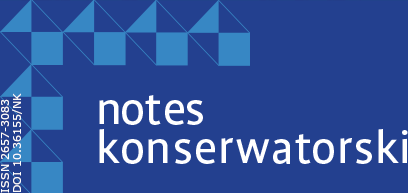O CZASOPIŚMIE
„Notes Konserwatorski” jest recenzowanym czasopismem naukowym, rocznikiem, wydawanym przez Bibliotekę Narodową. Czasopismo stworzone zostało w 1998 roku z myślą o ogólnopolskim środowisku konserwatorów zabytków na podłożu papierowym. Poświęcone jest tematyce ochrony i konserwacji zbiorów, książek, zbiorów ikonograficznych, kartografii i innych, jak np. fotografie. Czasopismo znajduje się na liście czasopism naukowych Ministerstwa Edukacji i Nauki z liczbą 40 punktów. czytaj więcej o czasopiśmie
NUMER BIEŻĄCY

STRONA REDAKCYJNA, OD REDAKCJI, s. 1–11 / CREDITS, EDITOR’S NOTE, p. 1–11
POLITYKA OCHRONY I KONSERWACJI ZBIORÓW / PRESERVATION AND CONSERVATION POLICY
Narodowy Zasób Biblioteczny – doświadczenia Biblioteki Naukowej PAU i PAN w Krakowie, s. 15–33 / National Library Resource: Insights from the PAAS and PAS Research Library in Cracow, pp. 15–33
The article presents a short history of the Scientific Library of the Polish Academy of Arts and Sciences and the Polish Academy of Sciences in Cracow as well as, in more detail, the part of their collections which upon a decree of September 16, 2016 was included into the National Librarian Collection: engravings, drawings, ex libris, pergamin diplomas, incunabula and old prints. A detailed plan of protection of this part of the Library signature contains guidelines regarding, among others, collection and making it available to the public. It is brought up to date every summer. Every year, the Library undertakes further works to ensure best conditions for its collections. Everyday monitoring of the atmosphere, special materials for storing are just a few of tasks realised at an institution of more than 150 years of librarian practice.
FIZYKA, CHEMIA I MIKROBIOLOGIA W OCHRONIE I KONSERWACJI ZBIORÓW / PHYSICS, CHEMISTRY AND MICROBIOLOGY IN PRESERVATION AND CONSERVATION
Japoński papier drukowy kyokushi – rys historyczny. Część I. Geneza i opracowanie metody produkcji, s. 37–98 / Japanese Kyokushi Printing Paper: A Historical Outline. Part I. Genesis and Production Methods, pp. 37–98
Kyokushi printing paper was first produced around 1876 using mitsumata fibre in a factory managed by a Ministry of Finance office. Its predecessor was banknote paper, production of which started due to the introduction of uniform, cross-country currency and when attempts to print banknotes in foreign countries failed. This was achieved using foreign examples and adapting them as per the “Japanese spirit, foreign technology” rule. At the turn of the 19th and 20th centuries the kyokushi paper was exported also to the USA and Europe, where it became very popular among the artistic circles. It used to be called “Japanese veil” due to occasionally spotted resemblance to real veil, parchment made from delicate animal skin. The article details, step-by-step, changes which took place in the Meiji and Taisho¯ periods when it comes to the way of producing kyokushi paper in Japan. In handicraft production steel sieves appeared next to the traditional bamboo ones – the European way. In time, mass production of paper started. Chemical wood pulp as well as very aggressive chemicals, sodium hydroxide and chlorine compounds started to be used, too.
HISTORIA, BADANIA I KONSERWACJA FOTOGRAFII / HISTORY AND CONSERVATION OF PHOTOGRAPHY
Archiwalne fotografie – polemika wokół wybranych terminów związanych z ich nazewnictwem, zniszczeniami i konserwacją, s. 101–142 / Archival Photography: A Polemic Around Selected Terms Related to Names, Destruction and Conservation, pp. 101-142, pp. 101–142
The publication attempts to signal a need for discussion around some commonly used, wrong or unprecise terms and borrowings in the conservatory circles when it comes to techniques of producing and protecting archive photos. “Analogue photography”, “photographic emulsion” or “digitalisation” and “white-and-black” or “single-colour” photography are just a few of terms used among theoreticians and practitioners in their daily work. The authors point out the terminological problem suggesting linguistic solutions to properly interpret the substance contained in projects and conservatory or documentation as well as research and scientific publications including the stages of reviewing and editing.
Obrazowanie wielospektralne fotografii, s. 143–161 / Multispectral Imaging of Photographs, pp. 143–161
The article discusses the meaning and examples of how multispectral imaging techniques can be used to study photographic collections. This non-invasive research technique allows to compile additional information about works of art, of historical value, complex technological structure or in bad condition. The text focuses on the process of multispectral imaging, but it also relates to previous research on imaging of different archival materials. It discusses examples of multispectral imaging various types of photographic prints as well as related problems – from fading of the picture through degradation resulting from fire. The selected examples made it possible to present basic possibilities of using MSI in the context of photographic archive.
Multispectral Imaging of Photographs, pp. 163–180
The article discusses the meaning and examples of how multispectral imaging techniques can be used to study photographic collections. This non-invasive research technique allows to compile additional information about works of art, of historical value, complex technological structure or in bad condition. The text focuses on the process of multispectral imaging, but it also relates to previous research on imaging of different archival materials. It discusses examples of multispectral imaging various types of photographic prints as well as related problems – from fading of the picture through degradation resulting from fire. The selected examples made it possible to present basic possibilities of using MSI in the context of photographic archive.
Z PRAKTYKI KONSERWATORA / FROM A CONSERVATOR’S PRACTICE
Seminarium Conservation of Tracing Paper, s. 183–187 / Seminar on the Conservation of Tracing Paper, pp. 183–187
KONFERENCJE, WARSZTATY, WYDARZENIA / CONFERENCES, WORKSHOPS, EVENTS
Kalendarium wydarzeń 2024, s. 191–200 / Calendar of Events in 2024, pp. 191–200

